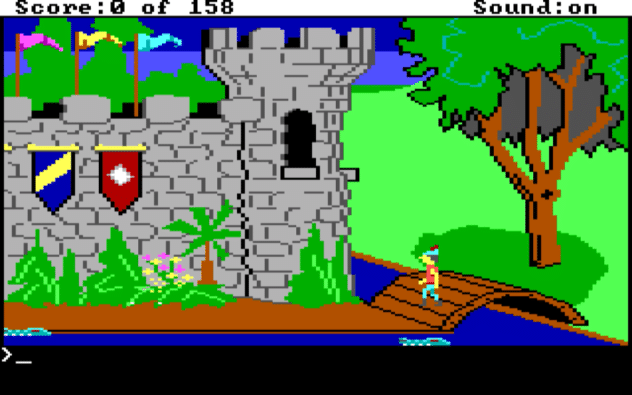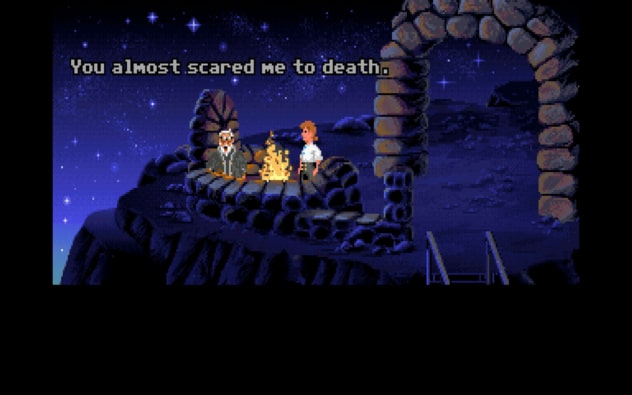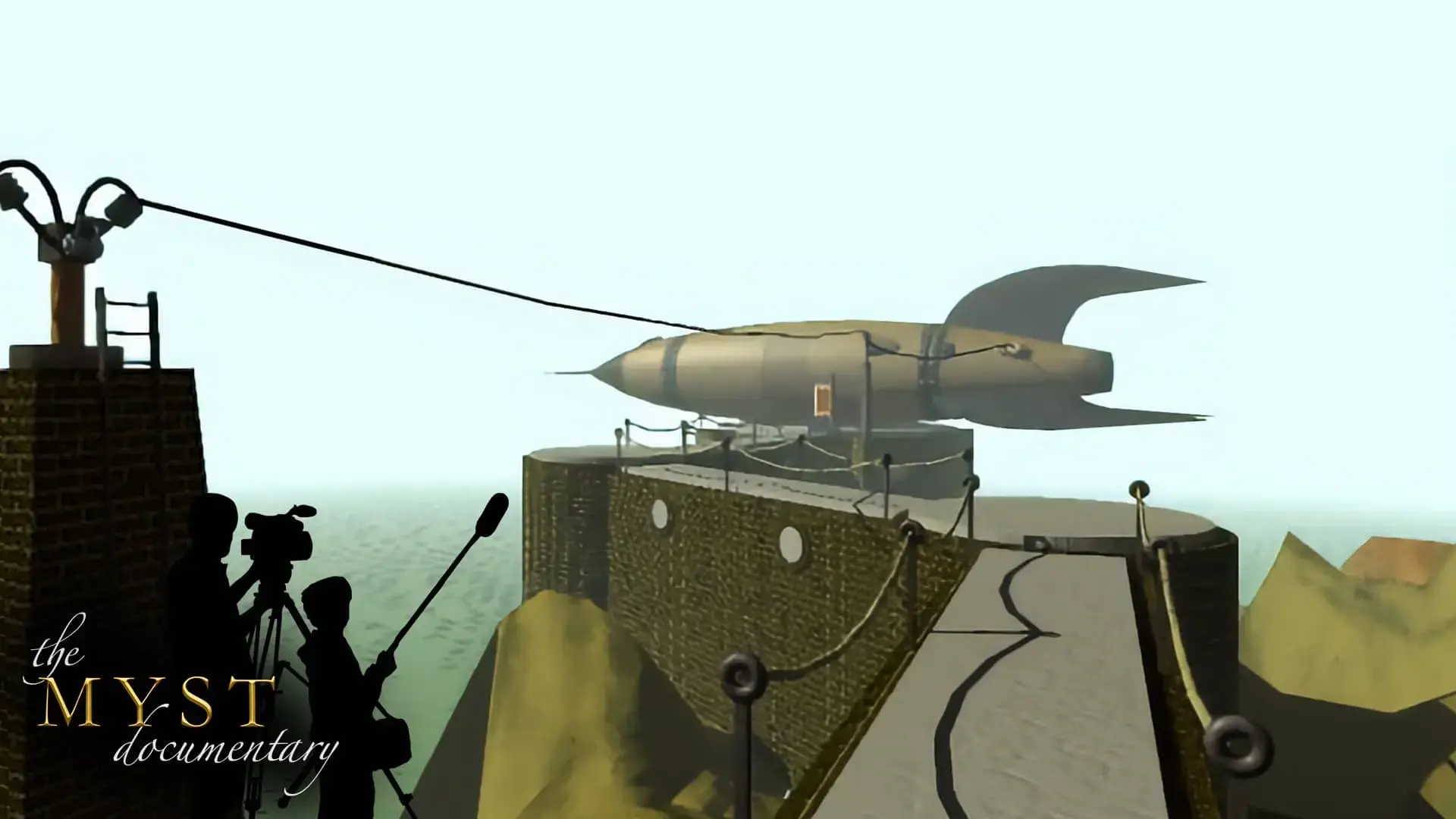The Complete History of Role-Playing Games (RPGs): Part 6 – Pointing and Clicking
Ever wondered where the idea of character levels or XP came from? Why fantasy is final? What RPGs looked like before graphics, or what the first massively multiplayer games were like to play? Here at Ultimate Gaming Paradise, we’ve got all those answers and much more in our series delving into the history of role-playing games.
Remember those text adventures of the early 80s? Things are about to get pretty colourful.
Episode Six: Pointing and Clicking
Roberta Williams is probably someone you have never heard of. Fair enough, but gaming owes a huge debt to this creative woman. In 1980, having played Colossal Cave Adventure (see part two of this series), she was convinced that the game would be a lot more fun if it was illustrated.
She wasn’t wrong.
Roberta had no programming experience and no real desire to become a coder, but she had a husband that was. She badgered him to turn her dream into a reality. He agreed, and together they created a game called Mystery House—a text adventure game with some basic line-art graphics to illustrate the locations.
It was the birth of yet another branch of story-based games.
Sierra is On-Line
Roberta and Ken Williams’ company On-Line Systems pumped out a few similar games in the very early 80s, before rebranding themselves as Sierra On-Line and producing the first interactive graphical adventure game. Its name? King’s Quest.
What King’s Quest did for the text adventure genre cannot be understated. For the very first time, the illustrations that accompanied the text were more than just static pictures. In King’s Quest, you watched as the little protagonist, Graham, walked from one place to another. Different areas of the picture provided clues, and Graham’s actions were animated as he did things like pick up objects or opened doors.
It wasn’t quite point-and-click, as all the inputs were done via the keyboard. This was 1984, and Windows-style graphic interfaces using a mouse were still in their infancy. The Apple Lisa had come out a year beforehand, and Microsoft’s first PC-based mouse drivers were ever newer than that. Pointer control in gaming was unheard of.
King’s Quest started a slew of similar games, many from Sierra. The company–which had quickly become a household name among fans of story-based puzzles–soon released more in the King’s Quest series, supplementing it with Space Quest and Police Quest.
In 1987 Sierra really broke ground, becoming famous (or is it infamous?) with the risqué title Leisure Suit Larry in the Land of the Lounge Lizards.

Leisure Suit Larry
It was impossible in the late 1980s to have an interest in adventure games and not come into contact with Leisure Suit Larry and his escapades. Parents hated it, teenagers loved it, and it was pirated across the globe with copies of the disks passing through hands in schools and universities everywhere.
The draw of Leisure Suit Larry wasn’t just that it was actually a good puzzle-based adventure game, but because it was filled with naughtiness. The main plot follows a lecherous 38-year-old who is desperate to lose his virginity. The game featured sleazy bar locations, prostitutes, and a lot of cheap innuendoes. It wasn’t deep, and it certainly wasn’t clever, but it was big. It worked.
It was, after all, the 1980s. Happily, today’s game-playing audience are a little more refined. Mostly.
Pushing the graphical capabilities of the PCs of the day, Leisure Suit Larry looked great. There was a lot of consideration taken to provide as much hi-resolution shininess as possible to the various women you met along the way. Being an MS-DOS compatible game was another boon, helping it spread on machines that were otherwise known for ‘serious’ work. School IT rooms had never been so busy.
Enter LucasArts
George Lucas is a man who has done a lot for fantasy and sci-fi lovers the world over. Star Wars notwithstanding, he was responsible for Industrial Light and Magic. This revolutionised the use of computer graphics in film and led to companies that revolutionised sound effects, such as Pixar and Skywalker Sound.
It might be easy to forget–despite its namesake–that he founded Lucasfilm Games.
In 1987, just around the time when Larry was lounging, Lucasfilm Games released a title of its own. It was called Maniac Mansion, a much-loved adventure game that brought a whole new level of interface design to the table.
Maniac Mansion had a core game engine known as SCUMM (Script Creation Utility for Maniac Mansion). The team at Lucasfilm Games developed it to simplify the creation of the game, automating some of the scriptings and making it easier for the game designers to develop locations and dialogue sequences.
Using SCUMM meant that Maniac Mansion was cleanly coded, offering a completely new way for players to interact with characters. Gone was the complicated text parser that worked to interpret typed commands. It was replaced with a point-and-click interface, an option-based way to select actions and commands. At first glance, it may have felt like some freedom was being taken away, but this simply streamlined the whole process, giving real direction to the game.
But the side-effects of SCUMM went far beyond Maniac Mansion. Firstly, it separated the core code from the game structure and data. This made SCUMM easy to port between platforms, making versions for different computers a breeze. Secondly, it carved the way for making another game with the same interface and control system–requiring only game-design creativity–without complicated reinventing-the-wheel coding.
In short, SCUMM, written for Maniac Mansion, made The Secret of Monkey Island possible.
Guybrush Who?
One of the most beloved and influential point-and-click adventure of all time is the 1990s classic The Secret of Monkey Island. A polished masterpiece, it’s bettered only, perhaps, by its own sequel—Monkey Island 2: LeChuck’s Revenge.
The Secret of Monkey Island follows the story of a wannabe pirate Guybrush Threepwood. He’s a bumbler, a bit of an idiot, but ultimately very funny and relatable.
Often when developing a story-based game, it’s easy to focus on the game itself and forget about the story. We talk about graphics and advances in interfaces but don’t go in-depth regarding the narrative or character development.
The Secret of Monkey Island is all about the plot and characters. It’s about the tiny interactions between Guybrush and the people he meets on the way, helped by little touches in the rooms that help create a believable world through animations and timing.
How it all comes together is what makes this particular game stand so tall.
By limiting the player’s conversational choices through the SCUMM-designed interface, LucasArts were able to direct the character interactions. As the player, you still got to decide what Guybrush says–but from a list of amusing options that are far better than you might have come up with alone. These selections allowed us to understand Guybrush as a person, barring him to say something out of character. We’re role-playing, but we’re doing so within defined boundaries designed to enhance our experience and make the whole thing more enjoyable.
With LucasArts and Sierra leading the field, the 1990s made point-and-click adventures very much part of the gaming zeitgeist.

Puzzling Through Adventures
As with any genre, adventure games started to branch out and various developers brought a selection of features to their titles.
While Sierra and LucasArts solidified the point-and-click adventure game as the natural successor to Infocom’s text-based adventures, others went in different directions.
In 1989, French developer Exxos released KULT: The Temple of Flying Saucers. An adventure game with its own point-and-click interface, KULT is heavily puzzle-based, with only a small amount of text to read and strange alien graphics to decipher. Some would argue that the developer’s debut title, Captain Blood, is another example of a role-playing adventure. But this pushes in another direction entirely.
Cinemaware, a company who were fans of film and strategy games, combined these things with a point-and-click interface to create It Came from the Desert in 1989, another brilliant game that focussed on the story. The game had one foot in the adventure/RPG camp, while the other was firmly placed in action and minigames.
Gobliiins, 1992, was another example of a hybrid that looked very much like a point-and-click adventure but played more like a puzzle game. At this point in the early 1990s, the lines between genres were becoming harder to define.
Looking Through the Myst
In 1993 it was all about the tech. It was the year that CD-ROM became viably priced for the public and with it the ability to cram tonnes more data onto a single disc. Data, in gaming terms, meant graphics and sound.
The game that encouraged people to upgrade their computer hardware was Myst. Originally just for the Apple Mac, Myst is a quiet point-and-click adventure game for the purist. The graphics at the time were mind-blowing.
It was full of 3D landscapes with objects that had lighting and texture. To the gaming public in 1993, Myst had to be seen to be believed.
It was a shame that the game was so dull.
Doubtless, there are a lot of Myst fans. But for all the vibrant graphics, the game didn’t push the genre forward in any other way–offering a confusing, slow adventure experience that was anathema to the gaming experience of the time. Nonetheless, it was incredibly successful and spawned four sequels (as well as selling a vast number of CD drives).
At the same time, Virgin Interactive Entertainment released The 7th Guest, another CD-ROM heavy title that was developed to show off the new technology. This time, it was with video content as well as pre-rendered 3D scenes.
The 7th Guest is a horror-styled puzzle adventure game, bringing voiceovers and impressive smooth-scrolling 3D environments to the genre. Like Myst, it showed that with the advent of new CD storage, things could only get better.
Bigger, anyway.
Coming Next…
With the various branches of the genre now established, creators could focus more on the development of in-depth world-building and enhancing systems. Come back next month when we explore the growing world of early 90s RPGs.

